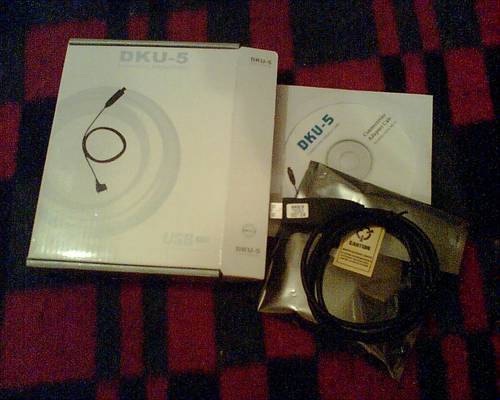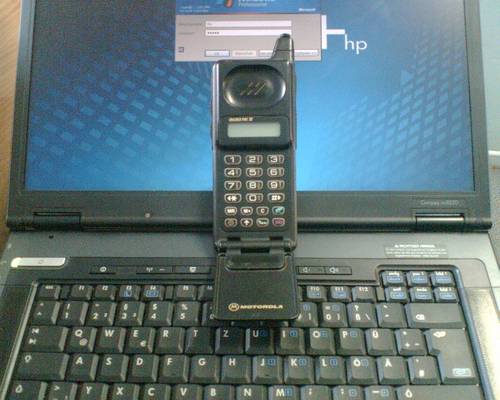What’s a data cable?
A data cable is a special cable that connects your mobile phone/PDA with a computer. Sometimes these are included (e.g. Motorola L6 & L7, Nokia 6233, 6280), but most of the time you’ll have to buy them extra.
Why would I need it?
- a) to up-/download user data on your phone (phonebook, pictures, videos, music, etc.)
- b) to synchronise it with your PIM (Outlook, Thunderbird, etc.)
- c) to access the internet via GPRS/EDGE
Are there any alternatives?
Yes. Bluetooth (BT) and InfraRed (IR). BT and IR of course require transceivers on both sides – a BT dongle or an iR diode. Both are often included on notebooks, and stand alone interfaces cost around Ksh. 1600 (BT) to 1800 (IR) downtown..
While IR tends to very slow among other disadvantages (line of sight with computer) and BT only being available with better phones & notebooks, it makes sense to invest some mbeca into a good data cable.
As I mentioned earlier, data cables for recent Nokia phones are relatively hard to come by in Kenya. These cables – copies from China (original ones cost around 5500 Ksh!! @ Nokia Shops) – are available, only: not every mobile phone accessory seller knows about them, and/or could inform you about the proper use of such special cables along with the equivalent software that normally comes with most better phones. It took me some time to ask for a reliable source, and I’ve meanwhile found it with J.J’s GSM Technology / Soft Link Mobiles in Uganda Hse, Kenyatta Ave., 4th Floor.

I’ve been flashing phones myself some time ago (updating the internal software on GSM phones, unlocking them, etc. – a bit tricky with Nokia phones due to Nokias strange policies), and repairing a phone mostly requires you to have a patient hand, a TORX 5 / 6 scredriver, some methylated spirit + ear-buds for cleaning (Isopropyl alcohol is even better) and some spare parts which are available with retailers.
The folks @ JJ’s/SoftLink really know their job, and also know to attract customers despite their workshop being on 4th floor. I went there on Sato and inquired about the Nokia data cables required to work with my colleague’s Nokia 6020s. We need such cables to connect their phones with the computers => internet via GPRS.
For the first time in Kenya, I had the feeling that my “interlocutor” (what a word, ama?) knew what I was talking about – you know, shop talk on geekstuff. Great! They of course managed to organize the required amout of cables and we tested them one by one. Now, these cables are cheap copies from China. However, sometimes they work – and the CD that came with them even included lots of interesting software (which you’ll normally find @ Yahoo Groups! or other places on the net). I bought one cable that I’ve taken to Embu for testing and if everything is fine, we’ll buy even more.

One of the customers had brought this ancient brick along for repair – a Motorola Micro Tac II. Sijui if this ETACS or GSM, but it doesn’t have a slot for SIM cards – the content of the SIM is directly loaded into the phone. I think it’s from 1989 or so, maybe also 1992. Anyways, ooooold stuff. I told him to clean it, give it to a jamaa in the US or UK and have it sold on Ebay.

Responses closed from the last entry but I noticed that the sex article from the Tribune is actually from the net at:
http://www.matrimonyxpress.com/2006/10/couples/10-things-men-never-want-their-women-to-say
and
http://www.askmen.com/dating/dating_top_ten_60/87_dating_list.html
Gooogooool power !
I have a DKU-5 cable – but I have never got it to work. I think the software CD it came with is defective (Also there are no instreuctions for donwloading the software of for syncronising it with a PC)
I got the new CA-42 cable for use with my phone from a third party vendor here in the US. I never got it to work with anything from Nokia, but on going to site, I found instructions and software to get it going. It now happily does all my data transfer.
I am in the process of trying to hook it up to my linux box at home (I use the data cable in the office where they are beholden to Microsoft), but so far have been unable to get it working with either gnokii or kandy. It looks like the system is not properly loading the drivers found in pl2303.c, so that is a continuing battle. If I succeed, I’ll probably do a howto post.
@Zak: ok, let me check. Articles from the net? LOL!! Now something tells me that was obvious.
==> MAYBE we should print out the feedout on Kenyaunlimited.com and have it printed every day. Should make a wonderful paper.
@Bankele: I can copy those drivers for you, no probs. As EGM says, you will first need to install that pl2303 thing as it helps to identify the SERIAL cable (which DKU-5 and CA-42 actually are) as USB cables. The difference between DKU-5 and DKU-2 cables (CA-42 and CA-53) is that DKU-5 is for phones that don’t come with a “usb chip” inside – afaik its the voltage which is 12V on a serial connection (COM1 etc.) and 5V on the USB port.
@egm: Thx for the links! Please keep us updated on your progress – I also had a hard time testing the cables with NokiaPCSuite…
O-My-God, I think have that phone! Well, almost – my first cellphone was the MicroTAC LITE II, bought in 1996 or 97. I upgraded about 2 years later to the MicroTAC 6503 :-) Both are boxed up, in excellent condition, waiting for a collector to make me an offer.
These were Analog phones, so if that customer’s TacII actually works over GSM, then it is newer than mine!
JKE, I checked the mobiles and pdas site I mentioned, and it looks like they might have gotten a cease and desist from Nokia. The information that was there when I first went to it is no longer in place, and neither is a link to the drivers I obtained from there. Those drivers work with any cable, be it from Nokia or from third-party vendors. I guess Nokia felt a pinch in their pockets from this, thus the C&D. I still have those drivers and remember what needs to get done to load them for anyone that may need them.